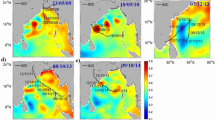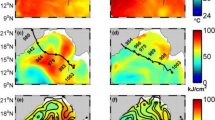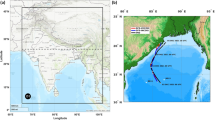Abstract
A numerical simulation of very severe cyclonic storm ‘Phailin’, which originated in southeastern Bay of Bengal (BoB) and propagated northwestward during 10–15 October 2013, was carried out using a coupled atmosphere-ocean model. A Model Coupling Toolkit (MCT) was used to make exchanges of fluxes consistent between the atmospheric model ‘Weather Research and Forecasting’ (WRF) and ocean circulation model ‘Regional Ocean Modelling System’ (ROMS) components of the ‘Coupled Ocean-Atmosphere-Wave-Sediment Transport’ (COAWST) modelling system. The track and intensity of tropical cyclone (TC) Phailin simulated by the WRF component of the coupled model agrees well with the best-track estimates reported by the India Meteorological Department (IMD). Ocean model component (ROMS) was configured over the BoB domain; it utilized the wind stress and net surface heat fluxes from the WRF model to investigate upper oceanic response to the passage of TC Phailin. The coupled model shows pronounced sea surface cooling (2–2.5 °C) and an increase in sea surface salinity (SSS) (2–3 psu) after 06 GMT on 12 October 2013 over the northwestern BoB. Signature of this surface cooling was also observed in satellite data and buoy measurements. The oceanic mixed layer heat budget analysis reveals relative roles of different oceanic processes in controlling the mixed layer temperature over the region of observed cooling. The heat budget highlighted major contributions from horizontal advection and vertical entrainment processes in governing the mixed layer cooling (up to −0.1 °C h−1) and, thereby, reduction in sea surface temperature (SST) in the northwestern BoB during 11–12 October 2013. During the post-cyclone period, the net heat flux at surface regained its diurnal variations with a noontime peak that provided a warming tendency up to 0.05 °C h−1 in the mixed layer. Clear signatures of TC-induced upwelling are seen in vertical velocity (about 2.5 × 10−3 m s−1), rise in isotherms and isohalines along 85–88° E longitudes in the northwestern BoB. The study demonstrates that a coupled atmosphere-ocean model (WRF + ROMS) serves as a useful tool to investigate oceanic response to the passage of cyclones.










Similar content being viewed by others
References
Alam MM, Hossain MA, Shafee S (2003) Frequency of Bay of Bengal cyclonic storms and depressions crossing different coastal zones. Inter J Climatol 23:1119–1125. doi:10.1002/joc.927
Ali MM, Jagadeesh PSV, Jain S (2007) Effects of eddies on Bay of Bengal cyclone intensity. Eos Trans AGU 88:93–95. doi:10.1029/ 2007EO080001
Babin SM, Carton JA, Dickey TD, Wiggert JD (2004) Satellite evidence of hurricane-induced phytoplankton blooms in an oceanic desert. J Geophys Res 109:C03043. doi:10.1029/2003JC001938
Behera SK, Deo AA, Salvekar PS (1998) Investigation of mixed layer response to Bay of Bengal cyclone using a simple ocean model. Meteorog Atmos Phys 65:77–91
Bender MA, Ginis I (2000) Real-case simulations of hurricane–ocean interaction using a high-resolution coupled model: effects on hurricane intensity. Mon Weather Rev 128:917–946. doi:10.1175/1520- 0493 (2000)128<0917:RCSOHO>2.0.CO;2
Bender MA, Ginis I, Kurihara Y (1993) Numerical simulations of the tropical cyclone-ocean interaction with a high-resolution coupled model. J Geophys Res 98:23245–23263
Bosart L, Velden CS, Bracken WE, Molinari J, Black PG (2000) Environmental influences on the rapid intensification of Hurricane Opal (1995) over the Gulf of Mexico. Mon Wea Rev 128:322–352
Carniel S, Barbariol F, Benetazzo A, Bonaldo D, Falcieri FM, Miglietta MM, Ricchi A, Sclavo M (2016) Scratching beneath the surface while coupling atmosphere, ocean and waves: analysis of a dense water formation event. Ocean Modeling 101:101–112
Chan JCL, Duan Y, Shay LK (2001) Tropical cyclone intensity change from a simple ocean-atmosphere coupled model. J Atmos Sci 58(2):154–172
Cione JJ, Uhlhorn EW (2003) Sea surface temperature variability in hurricanes: implications with respect to intensity change. Mon Weather Rev 131:1783–1796. doi:10.1175//2562.1
Cione JJ, Black PG, Houston S (2000) Surface observations in the hurricane environment. Mon Wea Rev 128:1550–1561
Chassignet EP, Arango HG, Dietrich D, Ezer T, Ghil M, Haidvogel DB, Ma CC, Mehra A, Paiva AM, Sirkes Z (2000) DAMEE-NAB: the base experiments. Dyn Atmos Oceans 32:155–183
D’Asaro EA (2003) The ocean boundary layer under hurricane Dennis. J Phys Oceanogr 33:561–579
Dudhia J (1989) Numerical study of convection observed during the winter monsoon experiment using a mesoscale two dimensional model. J Atmos Sci 46:3077–3107
Ekman VW (1905) On the influence of the Earth’s rotation on ocean currents. Arkiv for Matematik, Astronomi, och Fysik 2(11):1–52
Emanuel KA (1999) Thermodynamic control of hurricane intensity. Nature 401:665–669. doi:10.1038/44326
Fairall CW, Bradley EF, Rogers DP, Edson JB, Young GS (1996) Bulk parameterization of air–sea fluxes for Tropical Ocean Global Atmosphere Coupled Ocean-Atmosphere Response Experiment. J Geophys Res 101(C2):3747–3764
Foltz GR, McPhaden MJ (2009) Impact of barrier layer thickness on SST in the Central Tropical North Atlantic. J Clim 22:285–299. doi:10.1175/2008JCLI2308.1
Girishkumar MS, Ravichandran M, Han W (2013) Observed intraseasonal thermocline variability in the Bay of Bengal. J Geophys Res Oceans 118:3336–3349. doi:10.1002/jgrc.20245
Hong SY, Noh Y, Dudhia J (2006) A new vertical diffusion package with explicit treatment of entrainment processes. Mon Weather Rev 134:2318–2341
Haidvogel, DB, Arango, HG, Hedstrom, K, Beckmann, A, Malanotte-Rizzoli, P Shchepetkin, AF, (2000) Model evaluation experiments in the North Atlantic Basin: simulations in nonlinear terrain-following coordinates. Dyn Atmos Oceans 32, 239–281.
Hong SY, Lim JOJ (2006) The WRF single-moment 6-class microphysics scheme (WSM6). J Korean Meteor Soc 42(2):129–151
Jacob SD, Shay LK (2003) The role of oceanic mesoscale features on the tropical cyclone induced mixed layer response. J Phys Oceanogr 33:649676
IMD Report (2013) Very severe cyclonic storm, PHAILIN over the Bay of Bengal (08–14 October 2013): a report. India Meteorological Department, Technical Report, October 2013
Jacob SD, Koblinsky C (2007) Effects of precipitation on the upper-ocean response to a hurricane. Mon Weather Rev 135:2207–2225
Jacob, R, Larson, J, Ong, E, (2005) M x N communication and parallel interpolation in CCSM using the model coupling toolkit. Preprint ANL/MCSP1225-0205. Mathematics and Computer Science Division, Argonne National Laboratory, 25 pp
Jourdain NC, Lengaigne M, Vialard J, Madec G, Menkes CE, Vincent EM, Samson G, Jullien Barnier B (2013) Observation-based estimates of ocean mixing inhibition by heavy rainfall under tropical cyclones. J Phys Oceanogr 43:205–221
Kain JS (2004) The Kain-Fritsch convective parameterization: an update. J Appl Meteor 43:170–181
Kaplan J, DeMaria MJ, Knaff A (2010) A revised tropical cyclone rapid intensification index for the Atlantic and eastern North Pacific Basins. Weather Forecast 25:220–241. doi:10.1175/2009WAF2222280.1
Kumar VS, Nair AM (2015) Inter-annual variations in wave spectral characteristics at a location off the central west coast of India. Ann Geophys 33:159–167. doi:10.5194/angeo-33-159-2015
Large GW, McWilliams JC, Doney SC (1994) Oceanic vertical mixing: a review and a model with a nonlocal boundary layer parameterization. Rev Geophys 32:363–403
Leipper DF (1967) Observed ocean conditions and Hurricane Hilda, 1964. J Atmos Sci 24(2):182–186
Lin YL, Chen SY, Hill CM, Huang CY (2005) Control parameters for the influence of a mesoscale mountain range on cyclone track continuity and deflection. J Atmos Sci 62(6):1849–1866
Lin I et al (2003) New evidence for enhanced primary production triggered by tropical cyclone. Geophys Res Lett 30:1718. doi:10.1029/2003GL017141
Lin II, Chen CH, Pun IF, Liu T, Wu CCW (2009) Warm ocean anomaly, air sea fluxes, and the rapid intensification of tropical cyclone Nargis (2008). Geophys Res Lett 36:L03817. doi:10.1029/2008GL035815
Lloyd ID, Vecchi GA (2011) Observational evidence for oceanic controls on hurricane intensity. J Clim 24:1138–1153. doi:10.1175/ 2010JCLI3763.1
Lotliker AA, Kumar TS, Reddem VS, Nayak S (2014) Cyclone Phailin enhanced the productivity following its passage: evidence from satellite data. Curr Sci 106(3):360–361
Mandal M, Singh KS, Balaji M, Mohapatra M (2015) Performance of WRF-ARW model in real-time prediction of Bay of Bengal cyclone ‘Phailin’. Pure Appl Geophys. doi:10.1007/s00024-015-1206-7
Maneesha K, Murty VSN, Ravichandran M, Lee T, Yu W, McPhaden MJ (2012) Upper Ocean variability in the Bay of Bengal during the tropical cyclones Nargis and Laila. Prog Oceanogr 106:49–61
Marks F, Shay LK (1998) Landfalling tropical cyclones: forecast problems and associated research opportunities: report of the 5th prospectus development team to the US Weather Research Program. BAMS 79:305–323
Marchesiello P, McWilliams JC, Shchepetkin A (2003) Equilibrium structure and dynamics of the California Current System. J Phys Oceanogr 33(4):753–783
McPhaden MJ, Foltz GR, Lee T, Murty VSN, Ravichandran M, Vecchi GA, Vialard J, Wiggert JD, Yu L (2009) Ocean–atmosphere interactions during cyclone Nargis. EOS Trans AGU 90:53–54. doi:10.1029/ 2009EO070001
Michalakes J, Dudhia J, Gill D, Henderson T, Klemp J, Skamarock W, Wang W (2005) The Weather Research and Forecast Model: software architecture and performance, in: Proceedings of the Eleventh ECMWRF Workshop on the Use of High Performance Computing in Meteorology, Reading, UK, World Scientific 156–168
Mlawer EJ, Taubman SJ, Brown PD, Iacono MJ, Clough SA (1997) Radiative transfer for inhomogeneous atmosphere: RRTM, a validated correlated-k model for the long-wave. J Geophys Res 102:16 663–16 682
Morel A, Antoine D (1994) Heating rate within the upper ocean in relation to its bio-optical state. J Phys Oceanogr 24:1652–1665
Monin AS, Obukhov AMF (1954) Basic laws of turbulent mixing in the surface layer of the atmosphere. Contrib Geophys Inst Acad Sci USSR 151(163):e187
Nayak SR, Sarangi RK, Rajawat AS (2001) Application of IRSP4 OCM data to study the impact of cyclone on coastal environment of Orissa. Curr Sci 80:1208–1213
Neetu S, Lengaigne M, Vincent EM, Vialard J, Madec G, Samson G, Ramesh Kumar MR, Durand F (2012) Influence of oceanic stratification on tropical cyclones-induced surface cooling in the Bay of Bengal. J Geophys Res:117. doi:10.1029/2012JC008433
Noh Y, Cheon WG, Hong SY, Raasch S (2003) Improvement of the K-profile model for the planetary boundary layer based on large eddy simulation data. Bound Layer Meteor 107:401–427
Olabarrieta M, Warner JC, Kumar N (2011) Wave–current interaction in Willapa Bay. J Geophys Res 116:C12014. doi:10.1029/2011JC007387
Olabarrieta M, Warner JC, Armstrong B, He R, Zambon JB (2012) Ocean–atmosphere dynamics during Hurricane Ida and Nor’Ida: an application of the coupled ocean–atmosphere–wave–sediment transport (COAWST) modeling system. Ocean Model 43–44:112–137. doi:10.1029/2011JC007387
Pant V, Girishkumar MS, Udaya Bhaskar TVS, Ravichandran M, Papa F, Thangaprakash VP (2015) Observed interannual variability of near-surface salinity in the bay of Bengal. J Geophys Res 120(5):3315–3329
Phillips NA (1957) A coordinate system having some special advantages for numerical forecasting. J Met 4:184–185
Piontlovsky SA, Nezlin NP, Al-Azri A, Al-Hashmi K (2012) Mesoscale eddies, and variability of chlorophyll-a in the Sea of Oman. Int J Remote Sens 33(17):5341–5346
Price JF (1981) Upper-ocean response to a hurricane. J Phys Oceanogr 11:153–175
Ricchi A, Miglietta MM, Falco PP, Bergamasco A, Benetazzo A, Bonaldo D, Sclavo M, Carniel S (2016) On the use of a coupled ocean-atmosphere-wave model during an extreme cold air outbreak over the Adriatic Sea. Atmos Res 172–173:48–65. doi:10.1016/j.atmosres.2015.12.023
Riehl H (1950) A model of hurricane formation. J Appl Phys 21(9):917–925
Rao RR, Sivakumar R (2003) Seasonal variability of sea surface salinity and salt budget of the mixed layer of the north Indian Ocean. J Geophys Res 108(C1):3009. doi:10.1029/2001JC000907
Schade LR, Emanuel KA (1999) The ocean’s effect on the intensity of tropical cyclones: results from a simple coupled atmosphere-ocean model. J Atmos Sci 56(4):642–651. doi:10.1175/1520-0469
Schade LR (2000) Tropical cyclone intensity and sea surface temperature. J Atmos Sci 57:3122–3130
Sengupta D, Goddalehundi BR, Anitha DS (2007) Cyclone-induced mixing does not cool SST in the post-monsoon north Bay of Bengal. Atmos Sci Lett 9:1–6
Shay LK, Black PG, Mariano AJ, Hawkins JD, Elsberry RL (1992) Upper ocean response to Hurricane Gilbert. J Geophys Res 97(20):227–220
Shay LK, Goni GJ, Black PG (2000) Effects of a warm oceanic feature on Hurricane Opal. Mon Weather Rev 128(5):1366–1383
Shay LK, Brewster JK (2010) Oceanic heat content variability in the eastern Pacific Ocean for hurricane intensity forecasting. Mon Weather Rev 138(6):2110–2131. doi:10.1175/2010MWR3189.1
Shenoi SSC, Shankar D, Shetye SR (2002) Differences in heat budgets of the near-surface Arabian Sea and Bay of Bengal: implications for the summer monsoon. J Geophys Res 107: doi: 10.1029/2000JC000679. Issn: 0148–0227.
Skamarock WC, Klemp JB (2008) A time-split non-hydrostatic atmospheric model. J Comput Phys 227:3465–3485
Skamarock WC, Klemp JB, Dudhia J, Gill DO, Barker DM, Wang W, Powers JG (2005) A description of the advanced research WRF version 2. NCAR Technical Note, NCAR/TN-468 + STR
Song Y, Haidvogel D (1994) A semi-implicit ocean circulation model using a generalized topography-following coordinate system. J Comput Phys 115(1):228–244. doi:10.1006/jcph.1994.1189
Stommel H (1958) The abyssal circulation. Deep Sea Res 5:80–82
Subrahmanyam B, Rao KH, Rao NS, Murthy VSN (2002) Influence of a tropical cyclone on chlorophyll-a concentration in the Arabian Sea. Geophys Res Lett 29(22):1–22. doi:10.1029/2002GL015892
Subramanyam B, Murthy VSN, Sharp RJ, O’Brien JJ (2005) Air-sea coupling during the tropical cyclones in the Indian Ocean: a case study using satellite observations. Pure Appl Geophys 162:1643–1672
Subrahmanyam B, Ueyoshi K, Morrison JM (2008) Sensitivity of the Indian Ocean circulation to phytoplankton forcing using an ocean model. Remote Sens Environ 112:1488–1496
Sweeney C, Gnanadesikan A, Griffies S, Harrison M, Rosati A, Samuels B (2005) Impacts of shortwave penetration depth on large-scale ocean circulation heat transport. J Phys Oceanogr 35:1103–1119. doi:10.1175/JPO2740.1
Thadathil P, Muraleedharan PM, Rao RR, Somayajulu YK, Reddy GV, Revichandran C (2007) Observed seasonal variability of barrier layer in the Bay of Bengal. J Geophys Res:112. doi:10.1029/2006JC003651
Tummala SK, Mupparthy RS, Kumar NM, Nayak SR (2009) Phytoplankton bloom due to Cyclone Sidr in the central Bay of Bengal. J Appl Remote Sens 3(1):1–14. doi:10.1117/1.3238329
Venkatesan R, Shamji VR, Latha G, Simi M, Rao RR, Arul M, Atmanand MA (2013) In situ ocean subsurface time-series measurements from OMNI buoy network in the Bay of Bengal. Curr Sci 104(9):1166–1177
Venkatesan R, Mathew S, Vimala J, Latha G, Arul MM, Ramasundaram S, Sundar R, Lavanya R, MA A (2014) Signatures of very severe cyclonic storm Phailin in met–ocean parameters observed by moored buoy network in the Bay of Bengal. Curr Sci 107(4):589–595
Vialard J, Foltz GR, McPhaden MJ, Duvel JP, Montegut CB (2008) Strong Indian Ocean sea surface temperature signals associated with the Madden-Julian Oscillation in late 2007 and early 2008. Geophys Res Lett 35:L19608. doi:10.1029/2008GL035238
Vinayachandran PN, Shankar D, Vernekar S, Sandeep KK, Amol P, Neema CP, Chatterjee A (2013) A summer monsoon pump to keep the Bay of Bengal salty. Geophys Res Lett 40:1777–1782. doi:10.1002/grl.50274
Vincent EM, Lengaigne M, Madec G, Vialard J, Samson G, Jourdain N, Menkes CE, Jullien S (2012a) Processes setting the characteristics of sea surface cooling induced by tropical cyclones. J Geophys Res 117:C02020. doi:10.1029/2011JC007396
Vincent EM, Lengaigne M, Vialard J, Madec G, Jourdain N, Masson S (2012b) Assessing the oceanic control on the amplitude of sea surface cooling induced by tropical cyclones. J Geophys Res:117. doi:10.1029/2011JC007705
Walker ND, Leben RR, Balasubramanian S (2005) Hurricane-forced upwelling and chlorophyll a enhancement within cold-core cyclones in the Gulf of Mexico. Geophys Res Lett 32:L18610. doi:10.1029/2005GL023716
Warner JC, Armstrong B, He R, Zambon JB (2010) Development of a coupled ocean–atmosphere–wave–sediment transport (COAWST) modeling system. Ocean Model 35:230–244. doi:10.1016/j. oceanmod.2010.07.010
Warner JC, Armstrong B, Sylvester CS, Voulgaris G, Nelson T, Schwab WC, Denny JF (2012) Storm-induced inner-continental shelf circulation and sediment transport: Long Bay, South Carolina. Cont Shelf Res 42:51–63
Yablonsky RM, Ginis I (2013) Impact of a warm ocean Eddy’s circulation on hurricane-Induced Sea surface cooling with implications for hurricane intensity. Mon Weather Rev 141:9971021. doi:10.1175/MWR-D-12-00248.1
Zambon JB, He R, Warner JC (2014) Investigation of hurricane Ivan using the coupled ocean–atmosphere–wave–sediment transport (COAWST) model. Ocean Dyn 64(11):1535–1554
Zhu T, Zhang DL (2006) The impact of the storm-induced SST cooling on hurricane intensity. Adv Atmos Sci 23:14–22
Acknowledgements
The ocean observation programme of the National Institute of Ocean Technology (NIOT), Chennai, is gratefully acknowledged for the deployment and maintenance of OMNI buoy. OMNI buoy BD09 and BD10 data were acquired from the Indian National Centre for Ocean Information Services (INCOIS), Hyderabad. ECCO2 is a contribution to the NASA Modeling, Analysis, and Prediction (MAP) programme. KRP acknowledges UGC-CSIR for his fellowship support. The present study benefitted from the funding supports under the HOOFS programme of INCOIS, Hyderabad (ESSO, Ministry of Earth Sciences, Govt. of India), and the Ocean Mixing and Monsoon (OMM) programme of the National Monsoon Mission, Govt. of India. The High Performance Computing (HPC) facility provided by IIT Delhi and the Department of Science and Technology (DST), Govt. of India, are thankfully acknowledged. The authors thank the two anonymous reviewers for their constructive suggestions that helped to improve the manuscript. Graphics were generated in this manuscript using Ferret and NCL.
Author information
Authors and Affiliations
Corresponding author
Additional information
Responsible Editor: Sandro Carniel
Rights and permissions
About this article
Cite this article
Prakash, K.R., Pant, V. Upper oceanic response to tropical cyclone Phailin in the Bay of Bengal using a coupled atmosphere-ocean model. Ocean Dynamics 67, 51–64 (2017). https://doi.org/10.1007/s10236-016-1020-5
Received:
Accepted:
Published:
Issue Date:
DOI: https://doi.org/10.1007/s10236-016-1020-5




